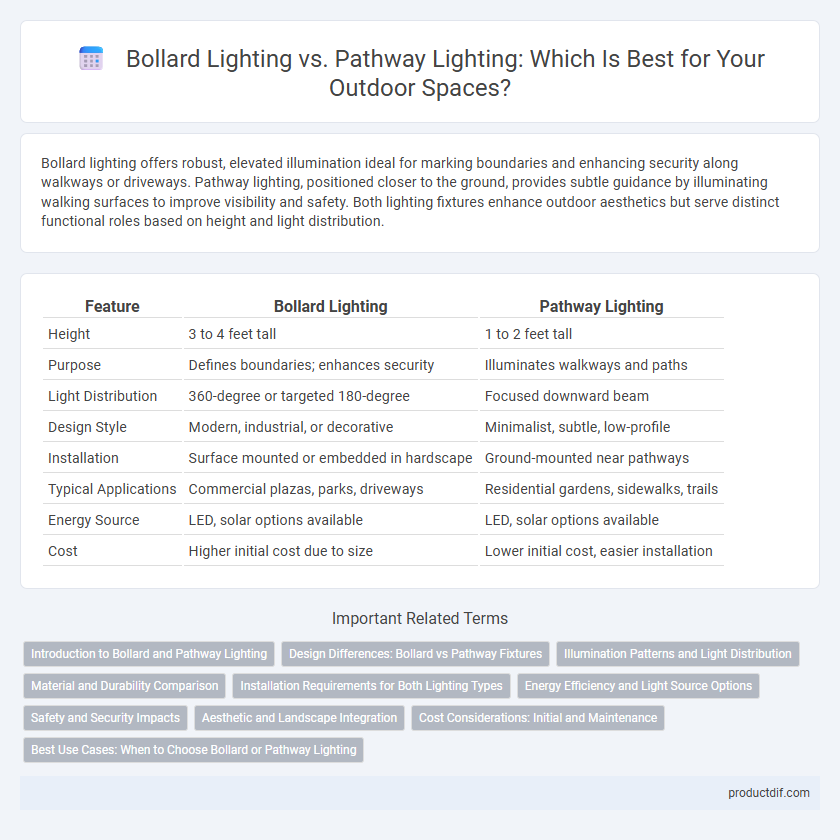Bollard lighting offers robust, elevated illumination ideal for marking boundaries and enhancing security along walkways or driveways. Pathway lighting, positioned closer to the ground, provides subtle guidance by illuminating walking surfaces to improve visibility and safety. Both lighting fixtures enhance outdoor aesthetics but serve distinct functional roles based on height and light distribution.
Table of Comparison
| Feature | Bollard Lighting | Pathway Lighting |
|---|---|---|
| Height | 3 to 4 feet tall | 1 to 2 feet tall |
| Purpose | Defines boundaries; enhances security | Illuminates walkways and paths |
| Light Distribution | 360-degree or targeted 180-degree | Focused downward beam |
| Design Style | Modern, industrial, or decorative | Minimalist, subtle, low-profile |
| Installation | Surface mounted or embedded in hardscape | Ground-mounted near pathways |
| Typical Applications | Commercial plazas, parks, driveways | Residential gardens, sidewalks, trails |
| Energy Source | LED, solar options available | LED, solar options available |
| Cost | Higher initial cost due to size | Lower initial cost, easier installation |
Introduction to Bollard and Pathway Lighting
Bollard lighting features short, sturdy posts designed to provide focused illumination for guiding pedestrians and enhancing landscape aesthetics, commonly used in gardens, walkways, and parking areas. Pathway lighting consists of low-level fixtures placed along walkways or driveways to improve visibility and safety by evenly illuminating the path. Both lighting types serve functional and decorative purposes, with bollards offering a more prominent light source and pathway lights delivering subtle, continuous lighting.
Design Differences: Bollard vs Pathway Fixtures
Bollard lighting fixtures feature tall, cylindrical shapes designed to provide 360-degree illumination, making them ideal for defining boundaries and enhancing landscape aesthetics. Pathway lighting fixtures are typically shorter with directional beams, focusing light downward to clearly outline walkways and improve safety without causing glare. The design differences also influence placement, with bollards often spaced further apart as prominent visual guides, while pathway lights are installed closely to create a continuous illuminated path.
Illumination Patterns and Light Distribution
Bollard lighting offers a more focused, cylindrical illumination pattern that creates defined pools of light ideal for marking boundaries and enhancing landscape features. Pathway lighting provides broader, lower-level light distribution designed to uniformly illuminate walking paths for safety and aesthetic appeal. The choice between bollard and pathway lighting depends on desired light spread and functional emphasis, with bollards emphasizing vertical visibility and pathway lights ensuring consistent ground-level illumination.
Material and Durability Comparison
Bollard lighting fixtures typically feature robust materials such as heavy-duty aluminum, stainless steel, or cast iron, offering enhanced resistance to physical impacts and harsh weather conditions. Pathway lighting often uses lighter materials like plastic or aluminum, balancing durability with cost-effectiveness but generally providing less resistance to corrosion and mechanical damage. The corrosion-resistant coatings and solid construction of bollard lights make them ideal for long-lasting outdoor installations requiring high durability.
Installation Requirements for Both Lighting Types
Bollard lighting requires sturdy foundation installation with concrete footings to ensure stability and durability in outdoor environments, often needing deeper ground anchoring compared to pathway lighting. Pathway lighting typically involves simpler installation using low-voltage wiring and ground stakes or small concrete bases, facilitating easier placement along walkways with minimal disruption. Both lighting types demand weather-resistant materials and proper electrical waterproofing to maintain safety and performance in exterior settings.
Energy Efficiency and Light Source Options
Bollard lighting often features energy-efficient LED bulbs with high lumen output, making it ideal for illuminating larger outdoor areas while minimizing energy consumption. Pathway lighting typically uses low-wattage LEDs or solar-powered options, optimizing energy use for subtle, focused illumination along walkways. Both lighting fixtures offer versatile light sources, but bollards generally support higher wattage LEDs, whereas pathway lights prioritize lower power options for sustainable, cost-effective operation.
Safety and Security Impacts
Bollard lighting provides enhanced security by offering robust, directional illumination that deters intruders and clearly defines property boundaries. Pathway lighting improves safety by evenly illuminating walkways, reducing trip hazards and guiding pedestrian traffic effectively. Both lighting types complement each other, with bollards emphasizing security measures and pathway lights focusing on safe navigation.
Aesthetic and Landscape Integration
Bollard lighting offers a bold, architectural presence that defines outdoor spaces with vertical emphasis, enhancing modern and structured landscape designs. Pathway lighting typically provides a low-profile, subtle illumination that softly guides movement while blending seamlessly with natural surroundings. Both lighting fixtures contribute to aesthetic appeal, but bollards serve as strong visual anchors, whereas pathway lights prioritize unobtrusive integration with the landscape.
Cost Considerations: Initial and Maintenance
Bollard lighting generally entails higher initial costs due to robust construction and integrated design features, making it suitable for premium outdoor spaces. Pathway lighting offers a more budget-friendly upfront investment with simpler installation and components, ideal for residential or low-traffic areas. Maintenance expenses for bollard lights can be higher because of their complex fixtures and weather-resistant materials, whereas pathway lights typically require less upkeep with easier access and fewer replacement parts.
Best Use Cases: When to Choose Bollard or Pathway Lighting
Bollard lighting is best suited for defining boundaries and providing focused illumination along walkways, driveways, and garden perimeters, enhancing safety and aesthetics in both residential and commercial landscapes. Pathway lighting excels in guiding pedestrians along paths, stairs, and entryways with lower-height fixtures that cast a gentle, diffuse glow to prevent glare and ensure visibility. Choosing bollard lighting is ideal for areas needing robust, directional light and a stronger physical presence, while pathway lighting works best for subtle, ambient illumination in garden paths and low-traffic zones.
Bollard lighting vs Pathway lighting Infographic

 productdif.com
productdif.com